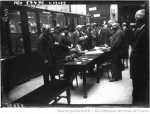1914 - 1918
First World War
The First World War caused the death of more than 10 million people, and permanently incapacitating injury to many others. The demographic deficit of the inter-war period was worsened by the Spanish flu epidemic, which swept Europe in 1918 and 1919 causing nearly 30 million deaths. The war also had major material repercussions, particularly on infrastructures. Governments took on a heightened role to finance the war effort between 1914 and 1918. But as public spending grew so did the need for new funds. In France, for example, income tax was created in 1914 to meet this need. Another consequence of the First World War was the arrival of women on the labour market, mobilised to deal with labour shortages in manufacturing, farming and transport. Lastly, governments universally abandoned the gold standard by withdrawing the possibility of converting banknotes into gold.



